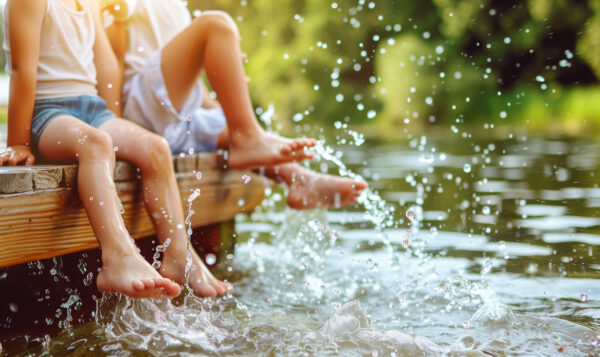
The Best Ways to Control Pond Algae
Algae is a simple, plant-like organism that thrives in freshwater environments. Although pond algae is a common occurrence in lakes and ponds, when their growth becomes excessive, they can pose significant problems. Excessive algae growth can deplete oxygen levels in the water, which can endanger fish and other aquatic life. It can also clog filters and pumps, hindering a lake or pond’s functionality. Not to mention, algae can create an unsightly appearance that diminishes a pond’s visual appeal and enjoyment.
Luckily, there are solutions for pond algae control. Pond algaecides are EPA-registered products specifically designed to kill or control algae, helping to effectively manage algae in lakes and ponds. When applied properly and safely by licensed professionals, algaecides are an environmentally-responsible way to control algae. There are various types of algaecides for ponds available, each suited to different types of algae and ecosystems.
Types of Pond Algae
Understanding the different types of pond algae is crucial for maintaining a healthy aquatic ecosystem. Knowing the specific type of algae present can help determine the appropriate treatment methods. There are three broad categories of algae: filamentous, planktonic, and macroalgae. One of the more harmful algae species to look out for is a planktonic species called cyanobacteria. Cyanobacteria, often referred to as blue-green algae, can produce toxins harmful to fish, wildlife, pets, and humans and has been known to plague popular recreational lakes and reservoirs. In addition to interfering with recreation, there is evidence that exposure to cyanotoxins may lead to the development of neurodegenerative diseases. That’s why it is vital to identify the types of algae in your lake or pond so that timely and effective measures for pond algae control can be implemented.
How Algae Grow in Ponds
Pond algae growth is primarily fueled by two key factors: high nutrient levels and the presence of sunlight combined with warm water temperatures. Nutrients, such as nitrogen and phosphorus, often enter ponds through runoff from fertilized lawns and agricultural lands. These nutrients act as a food source for pond algae, promoting their growth. Sunlight can also play a crucial role in algae development through photosynthesis, where algae convert sunlight into energy to grow. Warm water temperatures further facilitate this process, as many types of algae thrive and multiply more rapidly in warmer conditions. Together, these conditions create an ideal environment for algae to flourish.

Using Algaecides for Control
Pond algaecides are specialized chemicals designed to manage and mitigate algae growth in aquatic environments, such as lakes and ponds. Their primary function is to either inhibit the growth of algae or kill existing algae, thus helping maintain the ecological balance and aesthetic appeal of your waterbody. The way algaecides work depends on their active ingredients. Some common types include copper-based algaecides, which disrupt the algae’s photosynthesis process, and peroxide-based algaecides, which oxidize and break down the algae cells. Regular monitoring of water quality can help determine the need for treatment, ensuring that algaecides for ponds are used only as often as necessary to maintain a balanced aquatic environment.
Some stakeholders may have concerns about using algaecides. We understand that concern, which is why SOLitude only utilizes EPA-registered products that have undergone rigorous testing. To further ensure our applications are safe for the environment, all aquatic specialists are trained in safe application techniques and the use of precise product dosages.

Natural Algae Control Alternatives
If you’re looking for natural alternatives for pond algae control, there are some innovative and premium solutions, like nanobubbles and ultrasonic technologies. Nanobubbles are tiny gas bubbles that are about one million times smaller than regular bubbles. Due to their small size, these bubbles remain suspended in water for extended periods, providing prolonged oxygenation that disrupts the growth cycle of pond algae.
Additionally, a new innovative algae control device produces 360-degree ultrasonic frequencies to physically manage and prevent green algae, blue-green algae (cyanobacteria), and biofilms. When blue-green algae are exposed to ultrasonic frequencies, gas pockets inside the cell burst and escape, causing the algae to sink to the bottom and die. This technology also leverages advanced data analytics to monitor water quality in real time, including temperature, pH, turbidity, chlorophyll A, and conductivity.

Reduce the Likelihood of Future Algal Blooms
Proactive ongoing management plays a vital role in keeping water quality healthy and reducing the likelihood of future algal blooms. Implementing a comprehensive management plan that includes regular monitoring of water quality and nutrient levels can help identify potential issues before they escalate. Effective strategies to maintain healthy, balanced water quality include increasing oxygen levels through aeration, using beneficial bacteria or nutrient remediation products to consume excess nutrients, and introducing shoreline buffer plants that filter nutrients before they enter the water and promote pond algae growth.
By adopting these proactive measures and focusing on the overall health of the waterbody, you can help create a more resilient ecosystem that is less susceptible to pond algae. This not only enhances the aesthetic and recreational value of the water but also supports biodiversity and the well-being of aquatic life.
Watch: Pond Algae Control Strategies
SOLitude Lake Management is a nationwide environmental firm committed to providing sustainable solutions that improve water quality, enhance beauty and preserve natural resources.
SOLitude’s team of aquatic scientists specializes in the development and execution of customized lake, stormwater pond, wetland and fisheries management programs. Services include water quality testing and restoration, algae and aquatic weed control, installation and maintenance of fountains and aeration systems, shoreline erosion control, muck and sediment removal and invasive species management. SOLitude partners with homeowners associations, golf courses, private landowners, businesses and municipalities. SOLitude Lake Management is part of Rentokil, a leading business services company, operating across the United States, Canada and Puerto Rico.
For more information, visit SOLitude Lake Management at solitudelakemanagement.com, and connect on Facebook, LinkedIn and Twitter.










